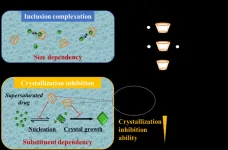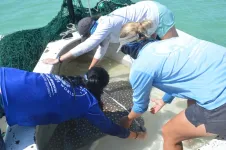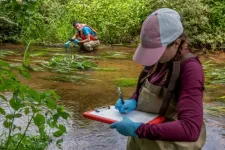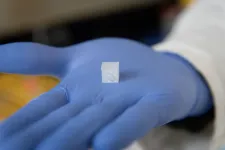(Press-News.org)
In the medicine market, most newly introduced drugs and drug candidates show poor water solubility, which prevents their absorption in the body. This, in turn, limits their therapeutic efficiency. Solubilizing agents such as cyclodextrins (CDs) are commonly employed to enhance their solubility. CDs have a cyclic structure featuring a hydrophilic exterior and a hydrophobic cavity inside that can enclose drug molecules to form inclusion complexes. However, solubilization does not necessarily enhance drug adsorption in the body, since the solubilized drugs cannot readily pass through biological membranes.
One way to improve the permeability of drugs through biological membranes is by increasing their concentration in the solution to form a supersaturated state. However, supersaturated states are unstable as the drug tends to precipitate and form crystals, limiting its effectiveness. To prevent this, the addition of effective crystallization inhibitors is necessary to stabilize drug supersaturation over a long period. CD derivatives are particularly advantageous as they can solubilize drugs as well as inhibit their crystallization. However, the mechanism underlying their crystallization inhibition effect remains poorly understood.
In this light, a study led by researchers from Chiba University, Japan, recently investigated the impact of 12 different CD derivatives with varying hydrophobic cavity sizes on crystallization inhibition of two poorly water-soluble drugs – carvedilol (CVD) and chlorthalidone (CLT).
Their work was made available online on March 22, 2023, and published in Volume 637 of the International Journal of Pharmaceutics on April 25, 2023. It involved contributions from Professor Kunikazu Moribe, Associate Professor Kenjirou Higashi, and Assistant Professor Keisuke Ueda.
“Different solubilization abilities of CD derivatives lead to different drug supersaturation levels, resulting in a misestimation of their crystallization inhibition strength. Thus, a systematic analysis of the drug crystallization inhibition effect while considering the solubilization effect of CD derivatives is essential,” explains lead author Mengyao Liu, a Ph.D. student at the Laboratory of Pharmaceutical Technology at the Graduate School of Pharmaceutical Sciences at Chiba University.
The researchers evaluated the solubilization and crystal inhibition effect of each CD derivative on the two drugs by performing phase solubility tests and measuring the crystallization induction time – the time taken for a supersaturated solution to form crystals. In a phase solubility test, they dissolved the drugs in CD derivative solutions of different concentrations and examined their solubility. For measuring the crystallization induction time, the researchers added the drugs in drops to form supersaturated solutions and then analyzed their concentrations at different time intervals after removing the precipitated crystals.
The phase solubility tests revealed that the addition of β-CD and γ-CD derivatives improved the solubility of CVD. However, CLT’s solubility was enhanced only by the β-CD derivative. “Notably, the degree of solubility improvement depends on the ability to form stable inclusion complexes that, in turn, depends on the size fitness between the drug molecule and the CD cavity,” explains Prof. Moribe.
However, there was no correlation between the solubilization effect of the different CD derivations and their crystallization inhibition abilities. Moreover, methylated CD derivatives were more effective than their unmethylated counterparts in maintaining the supersaturated state. The researchers attributed the crystallization inhibition ability of the methylated CD derivatives to their highly hydrophobic outer surfaces, which sterically hinder the nucleation and crystal growth processes, and thus maintain the supersaturated state. “We have discovered a novel function of methylated CD derivatives as effective stabilizers for supersaturated drugs, an effect that is independent of their inclusion complex formation ability,” highlights Prof. Moribe.
In conclusion, these findings shed light on the potential application of CD derivatives in drug-supersaturated formulations, which, in turn, could facilitate the clinical use of poorly water-soluble drug candidates.
About Professor Kunikazu Moribe
Dr. Kunikazu Moribe is a Professor at the Laboratory of Pharmaceutical Technology at the Graduate School of Pharmaceutical Sciences at Chiba University in Japan. His research focuses on physical pharmacy, pharmaceutical technology, and drug delivery systems. He has published over 183 papers on pharmaceutics, which have been cited over 3,000 times. In recognition of his contributions to the field, he was conferred the Asahi Kasei Pharmaceutical Technology Research Award for Young Scientists in 2013 by the Academy of Pharmaceutical Sciences and Technology Japan.
END
Ithaca, NY (May 15, 2023) - Today, the Boyce Thompson Institute (BTI) is taking a significant step forward in its mission to bridge the gap between scientific discovery and real-world application. Thanks to a generous $1M gift from the Cane-Bridge Foundation, BTI has launched an innovative translational program called "Project Vault!" to propel plant science discoveries into applications that tackle global life science challenges.
"The Cane-Bridge Foundation's support is vital to accelerate ...
SAN ANTONIO — May 15, 2023 —Southwest Research Institute (SwRI) scientists observed the first close-ups of a source of energetic particles expelled from the Sun, viewing them from just half an astronomical unit (AU), or about 46.5 million miles. The high-resolution images of the solar event were provided by ESA’s Solar Orbiter, a Sun-observing satellite launched in 2020.
“In 2022, the Solar Orbiter detected six recurrent energetic ion injections. Particles emanated along the jets, a signature of magnetic reconnection involving ...
Older buildings tend to leak heat through their walls, requiring much more energy to maintain a comfortable temperature in summer or winter. Those constructed prior to the late 1970s rarely meet today’s more rigorous energy standards. And yet they account for large proportion of the buildings standing today. In the US, about 44% of the residential building stock was built before 1970 and about half of the commercial buildings that exist today were built before the 1980s, which creates a significant need for energy retrofitting to reduce environmental impact. A new industry-academic collaboration between Jefferson and Lightweight ...
Asbestos materials were once widely used in homes, buildings, automobile brakes and many other built materials due to their strength and resistance to heat and fire, as well as to their low electrical conductivity. Unfortunately, asbestos exposure through inhalation of small fiber particles has been shown to be highly carcinogenic.
Now, for the first time, researchers from the University of Pennsylvania have shown that extremophilic bacteria from high temperature marine environments can be used to reduce asbestos’ toxicity. The research is published in ...
WHAT:
A first-in-human clinical trial of an experimental oral drug for removing radioactive contaminants from inside the body has begun. The trial is testing the safety, tolerability and processing in the body of escalating doses of the investigational drug product HOPO 14-1 in healthy adults. The National Institute of Allergy and Infectious Diseases (NIAID), part of the National Institutes of Health, is funding the Phase 1 trial, which is sponsored and conducted by SRI International of Menlo Park, California.
Internal radioactive contamination occurs when radioactive ...
Clam leases are designated underwater locations used to produce hard clams of all sizes from littlenecks to chowders. Clam production or aquaculture can be a risky business due in part to unwanted marine intruders. Among them, stealthy and highly mobile rays.
The Indian River Lagoon is one key location used for hard clam (Mercenaria mercenaria) aquaculture operations along Florida’s Atlantic coast. Clam fishermen have anecdotally reported seeing rays in clam leases and suspect that their interactions could result in damaged aquaculture gear and crushed clams. After all, ...
CAPE COD, MASSACHUSETTS – Earlier this year, the US Environmental Protection Agency proposed maximum allowable levels in drinking water for six PFAS (per- and polyfluoroalkyl substances) – so-called forever chemicals. But the draft standards do not account for half of the PFAS at contaminated sites across the country.
The findings are from a team led by the Harvard John A. Paulson School of Engineering and Applied Sciences (SEAS) and are published in the journal Environmental Science & Technology.
PFAS are present in fire retardant foams ...
Embargoed for release: Monday, May 15, 2023, 8:00 AM ET
Boston, MA – People who live in communities with higher proportions of Black and Hispanic/Latino residents are more likely to be exposed to harmful levels of per- and polyfluoroalkyl substances (PFAS) in their water supplies than people living in other communities, according to a new study led by researchers from Harvard T.H. Chan School of Public Health. The researchers link this finding to the disproportionate siting of sources of PFAS pollution—such ...
WINSTON-SALEM, NC – MAY 15, 2023 – The Wake Forest Institute for Regenerative Medicine (WFIRM) will make history this month when the first bioprinted solid tissue constructs soar to the International Space Station (ISS) on board the next all private astronaut mission by commercial space leader Axiom Space.
The Axiom Mission 2 (Ax-2) launch by Houston-based Axiom Space is launching from Florida’s Kennedy Space Center. The crew will conduct extensive scientific research experiments including WFIRM’s vascularized tissue research – which won first place in the NASA Vascular Tissue Challenge in 2021.
Liver ...
While a visit to the great outdoors is a common prescription for reducing screen use, a pioneering new study finds that time outdoors doesn’t always reduce smartphone screentime.
The new research, which tracked smartphone activity of 700 study participants for two years, reveals that participants’ smartphone activity actually increased during visits to city parks and other urban green spaces.
With smartphone use rising worldwide, the study clearly identifies a powerful way to reduce screen time: participants who visited nature reserves or forests saw significant declines in screentime over the first three hours, ...






